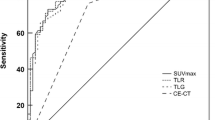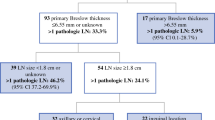Abstract
Background
The incidence of malignant melanoma has increased. Identification of additional prognostic factors may allow the development of individualized strategies. This multivariate analysis was undertaken to evaluate the potential role of the standard uptake value (SUV) in predicting disease-free and overall survival in melanoma patients with lymph node metastases.
Methods
All melanoma patients with palpable lymph node metastases who where referred for a fluorodeoxyglucose positron emission tomography scan were eligible. The SUV in the lymph node metastasis was calculated. Data were analyzed (Kaplan-Meier), and differences in cumulative survival and the disease-free rate were assessed (log-rank test). Univariate and multivariate analyses (Cox proportional hazard model) were performed to determine independent prognostic factors.
Results
There was no statistical difference in survival for the 38 patients with a high or low SUVmean (P = .11). However, a significant difference was found in disease-free survival (P = .03). Ulceration of the primary melanoma (P = .023) was an independent predictor of survival. For the disease-free survival, multivariate Cox regression showed adjuvant radiation (P = .001), localization of the primary melanoma (P = .017), and a high SUVmean (P = .009) as independent prognostic factors.
Conclusions
Disease-free survival of melanoma patients was prolonged in those with a low SUVmean value (P = .03) in their lymph node metastasis, as compared with those with a high SUVmean. However, this difference was not found for overall survival. In multivariate analysis, high SUVmean was an independent prognostic factor (P = .009) for disease-free survival. Prospective research should determine whether patients with a high FDG uptake in melanoma lymph node metastases could benefit from adjuvant radiation treatment or chemotherapy.


Similar content being viewed by others
References
Leiter U, Meier F, Schittek B, Garbe C. The natural course of cutaneous melanoma. J Surg Oncol 2004; 86:172–8
Reintgen DS, Cox C, Slingluff CL Jr, Seigler HF. Recurrent malignant melanoma: the identification of prognostic factors to predict survival. Ann Plast Surg 1992; 28:45–9
Soong SJ, Harrison RA, McCarthy WH, Urist MM, Balch CM. Factors affecting survival following local, regional, or distant recurrence from localized melanoma. J Surg Oncol 1998; 67:228–33
Meier F, Will S, Ellwanger U, et al. Metastatic pathways and time courses in the orderly progression of cutaneous melanoma. Br J Dermatol 2002; 147:62–70
Berdeaux DH, Meyskens FL Jr, Parks B, Tong T, Loescher L, Moon TE. Cutaneous malignant melanoma. II. The natural history and prognostic factors influencing the development of stage II disease. Cancer 1989; 63:1430–6
Balch CM. Cutaneous melanoma: prognosis and treatment results worldwide. Semin Surg Oncol 1992; 8:400–14
Gershenwald JE, Thompson W, Mansfield PF, et al. Multi-institutional melanoma lymphatic mapping experience: the prognostic value of sentinel lymph node status in 612 stage I or II melanoma patients. J Clin Oncol 1999; 17:976–83
Dong XD, Tyler D, Johnson JL, DeMatos P, Seigler HF. Analysis of prognosis and disease progression after local recurrence of melanoma. Cancer 2000; 88:1063–71
Mack LA, McKinnon JG. Controversies in the management of metastatic melanoma to regional lymphatic basins. J Surg Oncol 2004; 86:189–99
Mochiki E, Kuwano H, Katoh H, Asao T, Oriuchi N, Endo K. Evaluation of 18F-2-deoxy-2-fluoro-D-glucose positron emission tomography for gastric cancer. World J Surg 2004; 28:247–53
Wong RJ, Lin DT, Schoder H, et al. Diagnostic and prognostic value of [(18)F]fluorodeoxyglucose positron emission tomography for recurrent head and neck squamous cell carcinoma. J Clin Oncol 2002; 20:4199–208
Mijnhout GS, Hoekstra OS, van Tulder MW, Teule GJ, Deville WL. Systematic review of the diagnostic accuracy of (18)F-fluorodeoxyglucose positron emission tomography in melanoma patients. Cancer 2001; 91:1530–42
Allal AS, Dulguerov P, Allaoua M, et al. Standardized uptake value of 2-[(18)F] fluoro-2-deoxy-D-glucose in predicting outcome in head and neck carcinomas treated by radiotherapy with or without chemotherapy. J Clin Oncol 2002; 20:1398–404
Vansteenkiste JF, Stroobants SG, Dupont PJ, et al. Prognostic importance of the standardized uptake value on (18)F-fluoro-2-deoxy-glucose-positron emission tomography scan in non-small-cell lung cancer: an analysis of 125 cases. Leuven Lung Cancer Group. J Clin Oncol 1999; 17:3201–6
Oshida M, Uno K, Suzuki M, et al. Predicting the prognoses of breast carcinoma patients with positron emission tomography using 2-deoxy-2-fluoro[18F]-D-glucose. Cancer 1998; 82:2227–34
Minn H, Lapela M, Klemi PJ, et al. Prediction of survival with fluorine-18-fluoro-deoxyglucose and PET in head and neck cancer. J Nucl Med 1997; 38:1907–11
Sperti C, Pasquali C, Chierichetti F, Ferronato A, Decet G, Pedrazzoli S. 18-Fluorodeoxyglucose positron emission tomography in predicting survival of patients with pancreatic carcinoma. J Gastrointest Surg 2003; 7:953–9
Sugawara Y, Quint LE, Iannettoni MD, et al. Does the FDG uptake of primary non-small cell lung cancer predict prognosis? A work in progress. Clin Positron Imaging 1999; 2:111–8
Pandit N, Gonen M, Krug L, Larson SM. Prognostic value of [18F]FDG-PET imaging in small cell lung cancer. Eur J Nucl Med Mol Imaging 2003; 30:78–84
Eary JF, O’Sullivan F, Powitan Y, et al. Sarcoma tumor FDG uptake measured by PET and patient outcome: a retrospective analysis. Eur J Nucl Med Mol Imaging 2002; 29:1149–54
Van Westreenen HL, Plukker JThM, Cobben DCP, Verhoogt CJM, Groer H, Jager PL. Prognostic value of the standardized uptake value in esophageal cancer. AJR Am J Roentgenol 2005; 185:436–40
Wagner JD, Schauwecker DS, Davidson D, Wenck S, Jung SH, Hutchins G. FDG-PET sensitivity for melanoma lymph node metastases is dependent on tumor volume. J Surg Oncol 2001; 77:237–42
Crippa F, Leutner M, Belli F, et al. Which kinds of lymph node metastases can FDG PET detect? A clinical study in melanoma. J Nucl Med 2000; 41:1491–4
Dietlein M, Krug B, Groth W, et al. Positron emission tomography using 18F-fluorodeoxyglucose in advanced stages of malignant melanoma: a comparison of ultrasonographic and radiological methods of diagnosis. Nucl Med Commun 1999; 20:255–61
Macfarlane DJ, Sondak V, Johnson T, Wahl RL. Prospective evaluation of 2-[18F]-2-deoxy-D-glucose positron emission tomography in staging of regional lymph nodes in patients with cutaneous malignant melanoma. J Clin Oncol 1998; 16:1770–6
Gritters LS, Francis IR, Zasadny KR, Wahl RL. Initial assessment of positron emission tomography using 2-fluorine-18-fluoro-2-deoxy-D-glucose in the imaging of malignant melanoma. J Nucl Med 1993; 34:1420–7
Hamacher K, Coenen HH, Stocklin G. Efficient stereospecific synthesis of no-carrier-added 2-[18F]-fluoro-2-deoxy-D-glucose using aminopolyether supported nucleophilic substitution. J Nucl Med 1986; 27:235–8
Zimny M, Fass J, Bares R, et al. Fluorodeoxyglucose positron emission tomography and the prognosis of pancreatic carcinoma. Scand J Gastroenterol 2000; 35:883–8
Oyama N, Akino H, Suzuki Y, et al. Prognostic value of 2-deoxy-2-[F-18]fluoro-D-glucose positron emission tomography imaging for patients with prostate cancer. Mol Imaging Biol 2002; 4:99–104
Vansteenkiste J, Fischer BM, Dooms C, Mortensen J. Positron-emission tomography in prognostic and therapeutic assessment of lung cancer: systematic review. Lancet Oncol 2004; 5:531–40
Schwimmer J, Essner R, Patel A, et al. A review of the literature for whole-body FDG PET in the management of patients with melanoma. Q J Nucl Med 2000; 44:153–67
Bastiaannet E, Oyen WJ, Meijer S, et al. Impact of [18F] fluorodeoxyglucose positron emission tomography on surgical management of melanoma patients. Br J Surg 2006; 93:243–9
Keyes JW Jr. SUV: standard uptake or silly useless value? J Nucl Med 1995; 36:1836–9
Brink I, Klenzner T, Krause T, et al. Lymph node staging in extracranial head and neck cancer with FDG PET—appropriate uptake period and size-dependence of the results. Nuklearmedizin 2002; 41:108–13
Sugawara Y, Zasadny KR, Neuhoff AW, Wahl RL. Reevaluation of the standardized uptake value for FDG: variations with body weight and methods for correction. Radiology 1999; 213:521–5
Boellaard R, Krak NC, Hoekstra OS, Lammertsma AA. Effects of noise, image resolution, and ROI definition on the accuracy of standard uptake values: a simulation study. J Nucl Med 2004; 45:1519–27
Krak NC, Boellaard R, Hoekstra OS, Twisk JW, Hoekstra CJ, Lammertsma AA. Effects of ROI definition and reconstruction method on quantitative outcome and applicability in a response monitoring trial. Eur J Nucl Med Mol Imaging 2005; 32:294–301
Huang SC. Anatomy of SUV. Standardized uptake value. Nucl Med Biol 2000; 27:643–6
Minn H, Clavo AC, Grenman R, Wahl RL. In vitro comparison of cell proliferation kinetics and uptake of tritiated fluorodeoxyglucose and L-methionine in squamous-cell carcinoma of the head and neck. J Nucl Med 1995; 36:252–8
Minn H, Joensuu H, Ahonen A, Klemi P. Fluorodeoxyglucose imaging: a method to assess the proliferative activity of human cancer in vivo. Comparison with DNA flow cytometry in head and neck tumors. Cancer 1988; 61:1776–81
Haberkorn U, Strauss LG, Reisser C, et al. Glucose uptake, perfusion, and cell proliferation in head and neck tumors: relation of positron emission tomography to flow cytometry. J Nucl Med 1991; 32:1548–55
Author information
Authors and Affiliations
Corresponding author
Rights and permissions
About this article
Cite this article
Bastiaannet, E., Hoekstra, O.S., Oyen, W.J.G. et al. Level of Fluorodeoxyglucose Uptake Predicts Risk for Recurrence in Melanoma Patients Presenting With Lymph Node Metastases. Ann Surg Oncol 13, 919–926 (2006). https://doi.org/10.1245/ASO.2006.02.007
Received:
Accepted:
Published:
Issue Date:
DOI: https://doi.org/10.1245/ASO.2006.02.007




